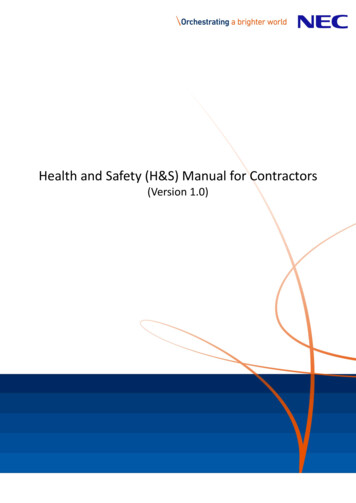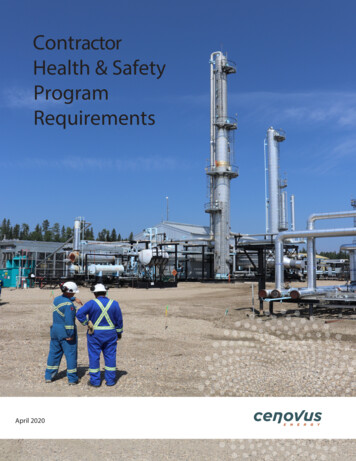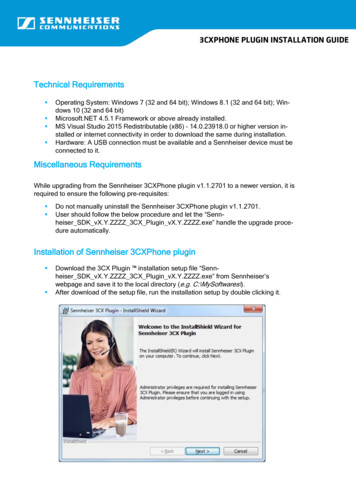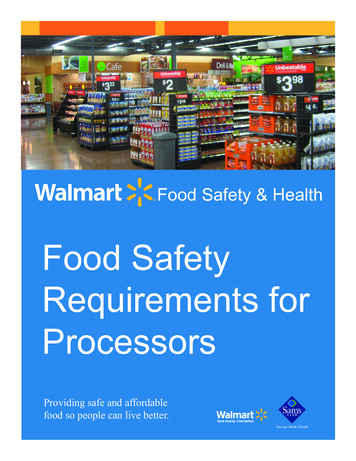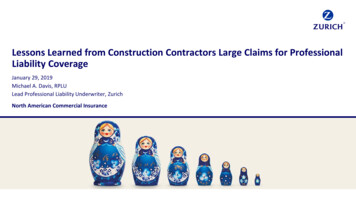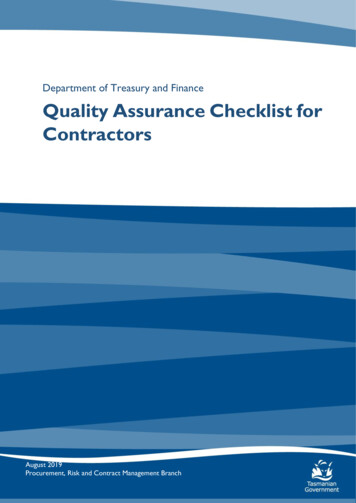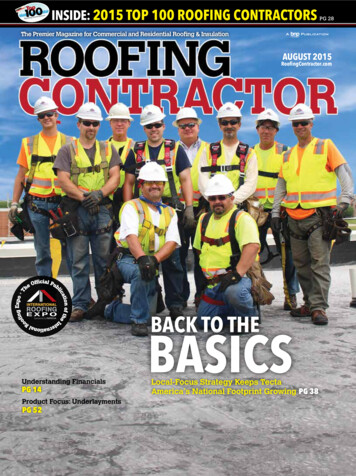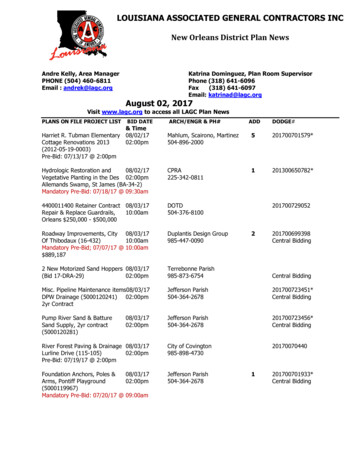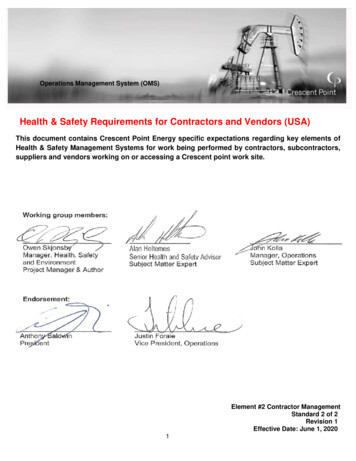
Transcription
1Operations Management System (OMS)Health & Safety Requirements for Contractors and Vendors (USA)This document contains Crescent Point Energy specific expectations regarding key elements ofHealth & Safety Management Systems for work being performed by contractors, subcontractors,suppliers and vendors working on or accessing a Crescent point work site.Element #2 Contractor ManagementStandard 2 of 2Revision 1Effective Date: June 1, 20201
Operations Management SystemPurposeThis Health and Safety Standard is set out to identify specific expectations by Crescent PointEnergy U.S. Corp (CPEUSC) to emphasize key elements of a Health & Safety ManagementSystem for all work being performed by contractors, sub-contractors, suppliers and vendorsworking on or accessing a CPEUSC work site.The intent of this standard is to ensure contractors, subcontractors, suppliers and vendors areproviding a consistent, safe work environment at all CPEUSC work sites or projects. This standardprovides a guideline for the timely implementation of a Safety Intervention Plan by CPEUSC ifdefined safety behaviors, initiatives or performance targets are not being met by the contractor,sub-contractors, suppliers and vendors.The contractors’ performance pertaining to health & safety management of the services providedmust comply with or exceed the requirements of all applicable laws and regulations, CPEUSChealth & safety requirements and industry best practices.The requirements are not intended to be all-inclusive or a definitive set of rules to meet allsituations; however, they are to be understood as the minimum acceptable levels of performanceregarding those aspects that all contract personnel must adhere to. Where there is conflictbetween regulations, codes, standards, best practices, contractor’s safety management systemrequirements, the most stringent shall apply.These requirements form part of the performance expectations to work on a CPEUSC site andas such are to be effectively integrated into the Contractor or Sub-Contractor Health and SafetyManagement System.The contractor and subcontractors shall actively promote safe working practices on behalf of theiremployees and shall implement and participate in activities to provide a safe working culture.As part of our expectations, CPEUSC strives to associate with innovative suppliers who areleaders in their industries that are willing to demonstrate a strong commitment to sustainabledevelopment by adopting health & safety, labor, environmental and ethical principles that ensurethe well-being of their employees and the communities they operate in.Page 2
Operations Management System1 Contractor Requirements1.1 Acts, Regulations, Laws and CodesAll contractors and subcontractors shall always abide by and be responsible for meeting orexceeding all applicable (federal, state and local) environmental, health, workers compensation,fire and safety laws or regulations.The current version of applicable Federal and State Government Acts & Directives, Regulations,Industry Recommended Practices, Laws and Codes must be followed, including but not limitedto, any required licensing of workers and inspections.Any Act, Regulation or Safety Code exemption that has been applied for and/or granted to anycontractor performing work on behalf of Crescent Point Energy, when CPEUSC is acting as thePrime Contractor, must be disclosed to the CPEUSC representative and the contractor and subcontractor must submit all relevant information for review and approval by CPEUSCManagement.1.2 Fit for Duty (Alcohol, Drugs and Substance Abuse)The Contractor and sub-contractor are responsible to ensure that:1) Personnel are aware of CPEUSC’s “Zero Tolerance” principle regarding alcohol and nonprescription drug use or prescription drugs that may impact the ability of personnel to safelyexecute their work on the worksite.2) The contractor shall implement post incident screening for just cause or allow Crescent Pointto conduct screening.3) The contractor and sub-contractor are to enforce their company “Fit for Duty Policy (Alcohol &Drug)”.1.3 Responsibility to Refuse Unsafe WorkOSHA regulation provides the right and responsibility of all personnel working on a worksite, notto perform work if, on reasonable and probable grounds, the worker believes that it will causean imminent danger to their personal health and safety, or the health and safety of anotherworker present at the work site. Workers shall report all Health & safety concerns aroundrefusing unsafe work to their direct site supervisor.CPEUSC firmly supports the right to refuse unsafe work and expects the contractor to ensurethat their health and safety orientation for all workers comprehensively covers this subject.Page 3
Operations Management System1.4 Worksite SupervisorsThe contractor must ensure that worksite leaders are competent to perform their roles.Contractors must have an auditable process in place that identifies and tests the leadership’scompetency to complete all tasks in a safe manner. Knowledge and abilities that leadershipmust have includes, but are not limited to:1.2.3.4.5.6.7.Knowledge of the laws and regulations applicable to the work to be performed.Knowledge of and expertise in the applicable safe work practices and task to be performed.Safe handling uses and storage of hazardous materials.Handling, usage, limitations and storage of personal protective equipment.Hazard identification and controls related to the work to be performed.Response to work site emergencies.Understand the duties and responsibilities of all workers supervised by the supervisor.1.5 Workers ResponsibilityBy OSHA workplace regulation, every worker has a responsibility to take reasonable measuresto protect the health and safety of themselves and other workers on the CPEUSC work site.All workers are required to report to work fit for duty as to perform their job in a safe andcompetent manner. Being fit for work means being both mentally and physically able to performone’s job requirements.All workers must refrain from causing or participating in harassment of any kind to anotherworker. CPEUSC believes in a respectful workplace and will ensure steps are taken to maintaina respectful workplace.Each worker must observe and follow all work directives and procedures required for the taskassigned whether given orally or in writing.All worker shall report any health & safety concerns to their direct supervisor or the CPEUSCsite representative.1.6 Short Service EmployeesAll contractors and subcontractors are to develop and implement a Short Service Employee(SSE) Management Program for the performance of the work related to the field operations. AnSSE is defined as a contractors’ employee:1. With less than 90 days continuous employment in the same type of job with the employingcontractor.Page 4
Operations Management System2. The contractor and subcontractors are responsible to inform CPEUSC or CPEUSCrepresentative of the number of SSEs on site at any given time.3. Contractor and subcontractor supervisors are directly responsible for SSEs on their workcrews and for ensuring that that everyone on the job site is aware the SSEs are on site. Allpersonnel should be encouraged to help the SSE and explain potential hazards before eachjob.4. Contractor and subcontractors must provide supervision and not allow the SSEs toindependently perform any task in which they have not demonstrated competency.5. To remove a worker from SSE status, the contractors must be satisfied that the SSE has: A working knowledge of the health and safety program and procedures that govern thejob site, and all tasks at hand. Demonstrated competent and safe work practices and behaviors.1.7 Training1. The contractor shall ensure that all workers are trained and deemed competent in thespecific aspects of the work that they will perform. The contractor shall also ensure that allworkers are fully aware of the intrinsic hazards and controls to be used for mitigation ofidentified hazards.2. All workers employed on a CPEUSC work site shall have the required H&S and requiredgovernment training certification needed to perform the tasks they have been assigned.3. At a minimum, all contractors’ workers shall have the following H&S training and certificatesto access all CPEUSC work sites: CPEC Safety Orientation First Aid H2S Clear or equivalent PEC Safeland, IADC Rig Pass or OSHA 101.8 Contractor Designated Health & Safety Advisor(s)1. Contractors’ Leadership shall be responsible and accountable for managing the health andsafety aspects of their work and for the work performed by their crews.2. As a minimum when, on a per shift basis, there are a total of:a. 1 to 10 contractors’ employees and / or subcontracted workers on site; the contractors’highest level of authority on site shall be responsible for all health & safety duties.b. 11 to 50 contractors’ employees and / or subcontracted workers on site; thecontractors’ highest level of authority on site shall be responsible for all health & safetyduties with the assistance of a part-time designated H&S Advisor who must attendthe worksite as set out by CPEUSC.c. 51 to 100 contractors’ employees and / or subcontracted workers on site; thecontractor’s highest level of authority on site shall be responsible for all health & safetyduties with the assistance of a full-time designated H&S Advisor.Page 5
Operations Management System1.9 Behavior Based SafetyThe contractor shall establish a Behaviour Based Observation Program and / or participate inthe CPEUSC BBS / Task Observation Program. The program is to focus on positive recognitionand opportunities for improvement. The program is to be properly resourced for success; withtraining provided to all personnel who work on-site. This will tie into CPEUSC’s near miss,hazard ID, task observation, stop and think reporting program.2 Incident ManagementThe contractor is to have a documented system for reporting, notification, investigation, andanalysis which is effectively carried out in a timely and consistent manner. CPEUSC believes thatprevention of incidents must be achieved by understanding current events, both actual andpotential incidents to properly identify trends. Trending of incidents enables both parties toproperly establish meaningful preventative action plans. Pro-active reporting (near miss or SIFpotential) forms an integral part of a sound Incident Management System.2.1 Reporting and Investigations of Incidents1.All incidents and high potential near miss incidents that occur on the job site or that involvepersonnel, environment, security breaches / threats, equipment damage, fire / explosion,any event that causes delay to a project, regulatory notifications or any Government StopWork Order and / or any event that CPEUSC considers as a possible impact upon thereputation of CPEUSC and as specified below must be, at a minimum, verbally reportedwithin 2 hours to CPEUSC, preliminary report within twenty four hours and a final report(if required) within seven days: Any personal injury resulting in:i. Lost time incident.ii. Restricted work case; oriii. Medical Aidiv. First Aid.Note: The Post Incident/Reasonable Cause Form shall be filled out on all personnel incidentsby a CPEUSC representative whenever the following occur:1. All SIF or SIF potential incidents (see CPEC Serious Incident & Fatalities preventionCOP).2. Incident(s) classified as a dangerous occurrence.3. All drug, alcohol and substance abuse non-compliances.Verbal Information that must be included when informing CPEC includes, but not limited thefollowing:Page 6
Operations Management Systema. Name of person reportingb. Location of the incidentc. Nature of the incident – personal injury, environmental, property damage, fire,explosion, equipment damage or a dangerous occurrence.d. Status of the site and personnel involved.e. Emergency services required.f. Names of all parties involved.g. Date and time of occurrence.4. Once the circumstances of an incident have been stabilized, the appropriate level ofinvestigation should be initiated by both CPEUSC and contractor.5. The contractor’s incident investigation process should determine the cause of the incidentalong with action items to prevent future incidents. This will be completed within 7 daysand forwarded to the CPEUSC representative or CPEUSC H&S advisor.6. CPEUSC reserves the right to participate on a contractor’s investigation team or toperform an independent investigation. All SIF and SIF potentials will be investigated byCPEUSC H&S Department.7. All applicable government agencies are to be notified according to the requirements ofexisting regulations. CPEUSC must be notified prior to all government notifications.3 First Aid, Medical and Emergency Response3.1 First Aid and Medical1. Contractors and subcontractors are required to have a properly trained first respondercomplete with all required equipment and supplies for their work sites. Contractors andsubcontractors shall meet or exceed OSHA requirements for first aid trained personnel.2. CPEUSC shall provide emergency first aid service and emergency transportation whenrequired by OSHA regulations.3.2 Emergency Response Plans1. Contractors and subcontractors shall have a written plan or shall be familiar with andadhere to CPUSC’s written plan to handle all emergency situations that could arise onthe site. This plan shall be effectively communicated to personnel and key responseinformation affixed at strategic locations in the workplace2. Site Emergency Response Plan(s) must address the following, at a minimum:a. Safe shutdown of all work activities.b. Safe egress routes and safe areas identified (muster points).Page 7
Operations Management Systemc.d.e.f.g.Responsibilities of key individuals for emergency response.Emergency phone numbers.Communication plan for on-site and offsite communication requirements.How and who has the authority to activate the Communication Plan.Procedure to provide timely access to offsite medical services, along with bestroute directions.3. The contractor’s or subcontractor’s emergency response plan must seamlesslyintegrate with the CPEUSC emergency response plan.4. The contractor shall develop a Rescue Plan and provision for a rescue team to coveroff all tasks that potentially could require rescue. (Confined Space / working fromheights/ trenches).3.3 Fire Prevention and ResponseThe contractor working with CPEUSC’s representative is responsible for developing a FirePrevention Plan and providing initial response and control of any fires / explosions resulting fromtheir activities.Contractors shall maintain, at the work site(s), adequate portable firefighting equipment in goodworking order, to fight and extinguish / control fire(s) caused by the contractors’ activities.CPEUSC shall provide major firefighting equipment, dependent on the scope work and risk.CPEUSC will follow all regulatory requirements and industry best practices when determiningwhen major firefighting equipment should be on the work site.3.4 Lessons LearnedAfter each actual emergency event, or an established drill, debrief of key personnel is to beconducted to establish a lesson learned action item list. The lessons learned are to be reviewedwith appropriate levels of both CPEUSC and contractor’s management for resolution of actionitems and sent to CPEUSC for documentation.4 Hazard Management and Control4.1 Hazard ManagementThe Contractor shall meet or exceed the governing laws, regulations and best practicesregarding the necessity for formal hazard and risk assessments to be performed prior to thecommencement of the work.Page 8
Operations Management SystemCPEUSC will fulfill their regulator obligation by having Operations and/or a CPEUSCrepresentative provide the contractor and subcontractors with a site hazard assessment to beused in completing their own assessment for the work being undertaken.Contractors must conduct hazard assessments at each phase of the work being completed, andwhenever there is a significant change of the physical or environmental conditions on theworksite. All revised hazard assessment must be reviewed by the onsite CPEUSCrepresentative before work can commence. All manners of hazards – physical, chemical,electrical, and environmental – must be identified, assessed, eliminated if possible, and ifelimination is not an option, adequate controls must be devised and implemented.Prior to initiating work, the nature of the work to be performed must be reviewed on a task-bytask basis. Those tasks that are viewed to have significant potential for harm (SIF or SIFpotential) to personnel, the environment or the equipment must be identified as critical andundergo a rigorous hazard assessment and be reviewed at a pre-job safety meeting with crewand the CPEUSC representative.Contingency actions must be pre-planned to cover the circumstances of a possible loss ofcontrol of a hazard. The plans must account for the possible escalation of consequences due toloss of control of the hazard.Results of all hazard assessments shall be recorded in a document (hard copy or electronic).Documents must be kept on-site and shall include a description of the hazard(s), the possibleadverse effects, relative risk or likelihood of occurrence, controls needed to contain thehazard(s), and precautionary measures for personnel and the environmental. CPEUSCreserves the right to audit current and past hazard assessments.Workers must be fully aware of all identified hazards and controls and have signed off on theassessment.4.2 Safe Work Authorization Permit1. CPEUSC will use the Safe Work Authorization Permitting system as an assessmentand communication process designed to prevent losses to people, equipment,material and potential damage to the environment. The main intent is to identify andcommunicate potential hazards, list appropriate controls, extra equipmentrequirements and special procedures necessary to complete the required task. Theprocess is also to communicate these requirements to all personnel that are involvedin the task or on site that could potentially be affected by hazards created during thecompletion of the task.Page 9
Operations Management System2. Contractors shall utilize and enforce the CPEUSC permit to work system toeffectively manage hazards that cannot be eliminated. The permit to work systemwill be used at all CPEUSC work sites in a manner that results in adequate andappropriate:a. Identification and assessment of hazards specific to the worksite.b. Identification of hazards caused by specific tasks.c. Elimination and/or control of identified hazards pertaining to the task.d. Emergency preparedness.e. Communication to all personnel involved in the task and all parties on the worksite.3. CPEUSC and the Contractors Safe Work Authorization process shall incorporate thefollowing:a. A physical inspection of the area where the work will be performed.b. Identification and assessment of the existing or potential hazards, controls andprotective measures to contain or eliminate the hazards; andc. A process that documents and authorizes the work to proceed in a safe manner.4. All ground disturbance activities shall utilize a permit to work system during theperformance of the work. Refer to CPEUSC Ground Disturbance Code of Practice forspecific information.5 Personal Protective Equipment GuidelinesPersonal Protective Equipment (PPE) forms part of the overall strategy in dealing with workplacehazards. As per regulations and industry, best practices the following controls are in order ofpriority:1. Engineering Controls.2. Administrative Controls (SOP, Codes of Practices, etc.).3. Personal Protective Equipment.As part of the hazard assessment process, the contractor shall identify the appropriate controlsto effectively manage the hazards that personnel are exposed to during the performance ofthe work.The contractor is responsible to ensure all their
PEC Safeland, IADC Rig Pass or OSHA 10 1.8 Contractor Designated Health & Safety Advisor(s) 1. Contractors’ Leadership shall be responsible and accountable for managing the health and safety aspects o
